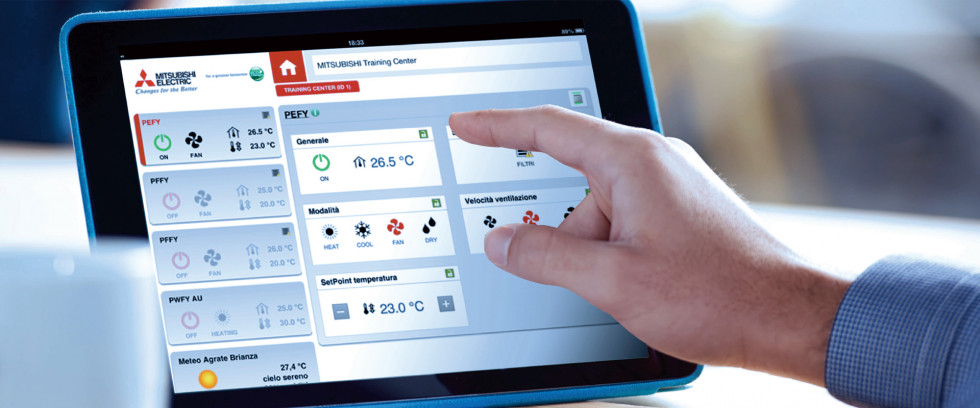For society, the term ‘digital’ represents a movement of change from the traditional to the advanced.
Over the past 40 years we’ve seen everything from traditional household items like ovens, microwaves and televisions move from dials and timers to digital displays with precise accuracy in cooking a meal or picking up a moving picture.
The digital revolution has also altered the way we work with most business processes relying heavily on computer and internet based systems.
Even the places we go for fun, like cinemas, shops and restaurants have also incorporate digital technology in one way or another – long are the days of a traditional film projector for example.
Digital is also changing the way we control our buildings, including our homes and are a great example of how we’ve moved from analogue, to digital, to smart!
But with more and more internet developments like the cloud and artificial intelligence, is innovation hovering on a thin line between good and bad?
Is going digital really best for everything?
Analogue vs. Digital
Until the 20th Century most measuring instruments were analogue (or analog as it’s often spelt). However since digital took off, analogue is now being coined to reference anything that isn’t digital.
In many cases analogue represents an analogy, for example an analogue watch represents an analogy of time, an analogue camera represents an analogy of the scene you want to capture and analogue sound recording represents an analogy of the sound you just heard.
Digital however converts information into numbers, often making things more accurate and allowing them to be edited and manipulated.
Both of which have pros and cons and both of which have been accepted differently, as I shall explore below.
Digital and the way we record music
I watched an interested documentary at the weekend called Sound City about a recording studio in California whose analogue tape data recordings on a Neve board (a hand-wired analogue mixing console) rocketed many bands into the charts over the 70s and 80s. Famous bands/artists that used this studio include Buckingham Nicks, Fleetwood Mac, Tom Petty and the Heartbreakers, Rick Springfield and Nirvana – who championed analogue recordings in the 90s making their Nevermind album a multi-platinum/diamond success.
But what was the crippling twist that changed the studio and music forever? The introduction of digital recording.
By the 80s music was changing and the audience was changing too. MIDI (Musical Instrument Digital Interface) introduced new digital music technologies like synthesisers and drum machines, and sequencing technology gave the 80s a distinctive sound. Then with the launch of the commercial digital CD, audio playing technology changed again.
For the consumer, CDs meant longer playtime and arguably the sound quality was better than that of vinyl or tape. But for the music industry, and recording studios in particular (as the documentary pointed out) the death of the traditional analogue recording began and by the late 90s recording studios were few and far between. After all, music could now be digitally recorded and altered via a computer in your bedroom.
But was this change a good thing or a bad thing?
The difference between a digital and analogue recording, as stated by Klipsch.com is that analogue recordings are made by imprinting the electrical anagoge signal onto the master tape or master recording from which copies can be made into cassette tapes and vinyl. Digital recordings however take the analogue signal and convert it into a digital representation of the sound – essentially it’s a series of numbers for digital software to interpret. This enables it to be put onto a CD or played as an MP3.
If you want to read more about the technicalities of sound recording I suggest you click here.
So in summary, the introduction of digital recording was a great step forward in technology, but with the variety of digital enhancements made accessible via software like Autotune; the raw, real and human side to analogue recorded music (which cannot be digitally altered), with all its tiny bits of human error and personality, was lost – which for many artists was bad and the quality of musicians and talent was jeopardised.
The Sound City documentary was written and directed by Dave Grohl of Nirvana and the Foo Fighters and can be watched via Netflix.
Digital and the way we tell the time
I’ve always been a fan of an analogue watch, mainly because they are classic and in my opinion look a lot nicer. I also think it’s because I associate digital watches with the 80s and 90s when Casio lead the way with futuristic digital time pieces that most boys at my school drooled over.
Analogue watches display time with hands on a dial and have traditionally been investment pieces, crafted with precision and usually sold for a premium price; although nowadays an analogue watch is much more accessible due to quartz, batteries and mass production so we have a wide variety of choice available to us.
Digital watches display time in numbers and symbols and are usually small and inexpensive allowing them to be easily incorporated into devices such as microwaves and computers – in fact when you look around digital displays are everywhere!
The interesting thing that links these two time pieces together however is that most wristwatches and clocks are only classed as analogue or digital based on their display. Essentially their inner workings are the same and can be either mechanical or electronic.
Regardless of this it’s often said that digital clocks are more precise and as we move to smart devices like the smart watch, the digital display is and will remain part of everyday life. As a wearable watch however, I’ll always be a fan of an analogue display set into a bracelet, and by the looks of things the digital display will always struggle to compete with this luxury watch market.
However with the new sweep of smart watches we’re seeing a hybrid of an analogue face in a digital display (often labelled as smart analogue) with more choices for your clock setting so I think in this case, manufactures have accepted that the best of both worlds is the way to go.
Digital and the way we control our heating
You might not realise this unless you work with heating systems, but analogue and digital form two types of thermostats used to control your home heating. Analogue thermostats are battery powered and use a dial to control the temperature of your heating at home. Digital wired and wireless thermostats however have a wider availability of control, often incorporating digital LCD screens, making the user experience at lot easier.
Analogue controls are often considered as the “old” way to heat your home and as is the case with most analogue devices, are considered not a precise as digital controls. Digital controls provide time and temperature displays allowing you to monitor your performance with the potential to save money on your bills.
As we have seen with a lot of electronics however, the move from analogue to digital is now shifting again to Smart. The cloud offers even more advance offerings and for heating controls, a smart meter or a smartphone compatible app is extremely popular.
At Mitsubishi Electric we also champion digital and smart controls. As a building owner, maintenance manager or facilities manager/management company, digital controls on HVAC systems like Remote Monitoring Interface allow advance monitoring and control for optimisation of energy use to save money and lower carbon emissions.
At home our digital controllers can be used in the same way once connected to your Ecodan heating system. Both at home or in commercial/office buildings smart phone compatible apps are available allowing systems to be monitored and controlled from anywhere in the world.

Final thoughts
There are many other examples highlighting the pros and cons of changing from analogue systems to digital systems such as TV aerials, cameras and radios, but I think both technologies need to be appreciated and both have their places in the modern world.
However what I do think is really important is quality, whichever technology delivers the greater quality and the more sustainable output always wins for me.
With sound recording analogue is real and raw, and like Dave Grohl, I think the quality of talent that analogue recording engineers possesses creates a higher quality output, even though I do appreciate digital playback when I listen to music at home.
With wristwatches analogue is classic and timeless (pun intended) and I think the quality of craftsmanship, even if mass produced, has the better output. After all, the turnover of digital devices means a smart watch for example is redundant after two years as we all move onto the new model.
However with controls and other forms of clocks, being digital and smart allows for more precision, more control, more accuracy, which is an extremely important quality when saving energy in a building or at home – something we all need to do to sustain the quality of our planet.
What do you think? What do you prefer?
Ellina Webb is a Senior Marketing Executive at Mitsubishi Electric
If you have any questions about this article, you can contact us via email. Or if you would like to tweet us, please follow our MEUK_LES twitter page.
We upload new articles every week so remember to check back regularly.
You can also sign up for our monthly newsletter below.


